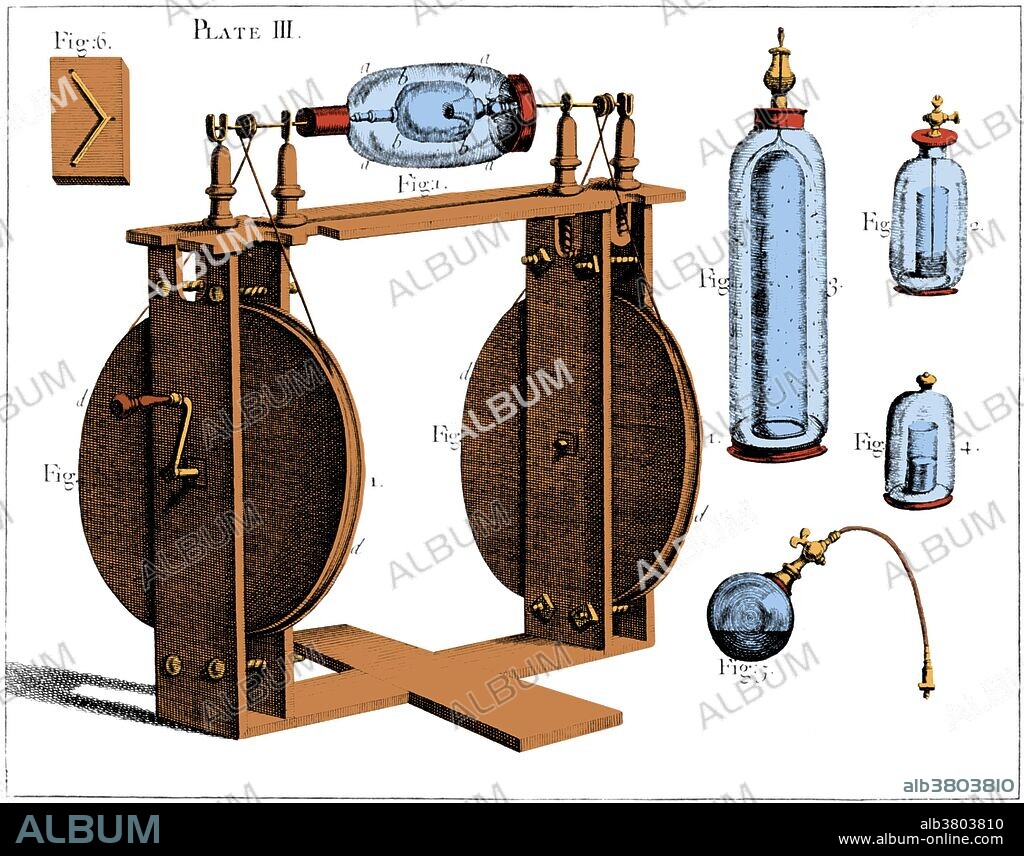alb3803810
Hauksbee Electrical Machine, 18th Century

|
Add to another lightbox |
|
Add to another lightbox |



Title:
Hauksbee Electrical Machine, 18th Century
Caption:
Hauksbee's electrical machines in which two glass vessels were independently rotated, one within the other. A dry hand applied o the outer revolving vessel produced a glow in the inner one. Turning both in a common or in opposite directions gave a more brilliant light. Francis Hauksbee the Elder (1660-1713) was an English scientist. In 1705 Hauksbee discovered that if he placed a small amount of mercury in the glass of his modified version of von Guericke's generator, evacuated the air from it to create a mild vacuum and rubbed the ball in order to build up a charge, a glow was visible if he placed his hand on the outside of the ball. The glow was bright enough to read by. This effect became the basis of the gas-discharge lamp, which led to neon lighting and mercury vapor lamps. In 1706 he produced an "Influence machine" to generate this effect. In 1709 he published Physico-Mechanical Experiments on Various Subjects which summarized much of his scientific work. This image has been color enhanced.
Credit:
Album / Science Source / New York Public Library
Releases:
Model: No - Property: No
Rights questions?
Rights questions?
Image size:
4200 x 3292 px | 39.6 MB
Print size:
35.6 x 27.9 cm | 14.0 x 11.0 in (300 dpi)
Keywords:
18TH CENTURY • 18TH CENTURY, THE • 18TH • APPARATUS • ART • ARTWORK • CELEBRITIES • CELEBRITY • COLOR ENHANCED • COLOR ENHANCEMENT • COLOR • COLOR-ENHANCED • COLORIZATION • COLORIZED • DEVICE • DRAWING • ELDER • ELECTRIC • ELECTRICAL • ELECTRICITY • ELECTRO-STATICS • ELECTROSTATICS • ENERGIA • ENERGY • ENGLISH • EQUIPMENT • EUROPEA • EUROPEAN • FAMOUS • FRANCIS HAUKSBEE • FRANCIS HAWKSBEE • GENERATOR • HAUKSBEE ELECTRICAL MACHINE • HAUKSBEE • HAWKSBEE ELECTRICAL MACHINE • HAWKSBEE • HISTORIC • HISTORICAL • HISTORY • ILLUSTRATION • ILLUSTRATIONS • IMPORTANT • INSTRUMENT MAKER • INVENTION • MACHINE • NOTABLE • PHYSICS • SAVANT • SCIENCE • SCIENTIST • STATIC ELECTRICITY • WELL-KNOWN
 Pinterest
Pinterest Twitter
Twitter Facebook
Facebook Copy link
Copy link Email
Email

